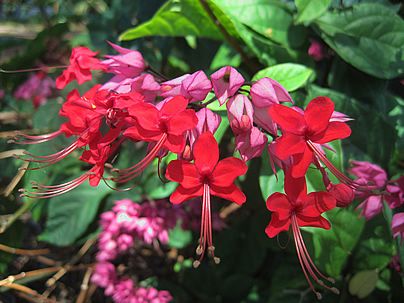The Red Bleeding Heart Vine (Clerodendrum x speciosum) is a climbing and tropical shrub, originating from the hybridization of two other species of Clerodendrum, the Bleeding Heart (Clerodendrum thomsonae) and the Flaming Glorybower (C. splendens). The crossbreeding of these two species produced a hardy plant with spectacular flowering, featuring flowers similar to Bleeding Heart, but with colored calyces and denser clusters. Its long, semi-woody branches can be easily trained as a climber with proper staking. The leaves are dark green, oval-shaped, opposite, with pronounced veins and slightly wavy margins.
The inflorescences appear in spring and summer, and are of the panicle type, terminal, with numerous red, tubular flowers with long stamens, surrounded by a persistent, white calyx, tinged with red or dark pink. Like the plants from which it originated, the bleeding-heart is very attractive to hummingbirds and butterflies.

Although essentially a shrub, the Clerodendrum x speciosum is more commonly purchased and used with the aim of being an elegant climber. However, it is necessary to stake the naturally arching and drooping branches, which can be bent and tied over a suitable support. Despite being vigorous, the bleeding-heart is a relatively light plant, which does not thicken the stem excessively, and can be trained over not so robust supports such as grids, trellises, and fences, as well as over trees, columns, arbors, walls, arches, porticos, etc.
The red bleeding heart is especially interesting for softening buildings when trained near them. The dark green of its leaves is very attractive and serves as a backdrop, providing an interesting contrast to other plants. It can be planted in pots and planters, also decorating well-lit indoor environments.
It should be grown in partial shade or filtered shade, in fertile, drainable soil, enriched with organic matter, and watered regularly. It tolerates full sun but prefers the coolness and humidity of partial shade. In temperate climate areas, with intense cold in winter or after some frost, the red bleeding heart loses its leaves, sprouting vigorously in spring. Reduce watering in winter.
Fertilize the red bleeding heart monthly with a liquid fertilizer suitable for the vegetative period, whether for growth or flowering. Apply organic fertilizers annually, such as vegetable soil and cured manure, at the end of winter to improve soil conditions. In the same period, prune by eliminating dry and diseased branches, and after flowering, remove the old inflorescences for a better appearance of the plant. Training prunes stimulate the densification of the plant, especially when left to grow as a shrub. It does not produce viable seeds. Propagate by separating the shoots that spontaneously arise around the mother plant and by cuttings, rooted in a moist substrate, in a protected place, such as a nursery or greenhouse.


